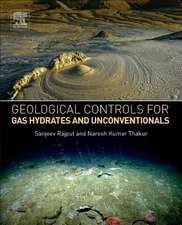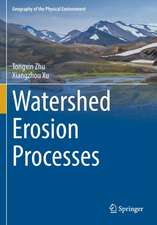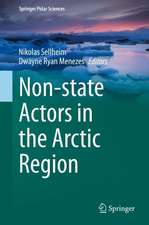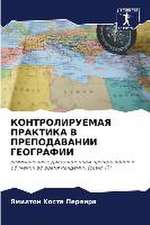Transformation of the natural environment in Western Sørkapp Land (Spitsbergen) since the 1980s: SpringerBriefs in Geography
Editat de Wiesław Ziajaen Limba Engleză Paperback – 15 dec 2015
This revised edition describes the transformation of the environment and landscape of Western Sørkapp Land based on research data collected by Jagiellonian University scientific expeditions in the period 1980–1986 and in 2008. It also outlines potential directions of the transformation of Western Sørkapp Land.
Western Sørkapp Land has been experiencing dramatic natural changes such as glacial recession, coastline retreat, emergence of new landforms and Quaternary deposits, as well as changes in the water drainage and network due to global warming. Western Sørkapp Land is a very remote and diverse region, which is representative of the European Arctic. The establishment of South Spitsbergen National Park has led to a regeneration of the local reindeer herd, which has caused overgrazing of the local tundra resulting in altered plant communities and soil erosion. They have also destroyed numerous bird nests. The transformation of Western Sørkapp Land is set to continue.
Din seria SpringerBriefs in Geography
-
 Preț: 411.32 lei
Preț: 411.32 lei -
 Preț: 377.18 lei
Preț: 377.18 lei -
 Preț: 380.63 lei
Preț: 380.63 lei -
 Preț: 381.98 lei
Preț: 381.98 lei -
 Preț: 379.09 lei
Preț: 379.09 lei -
 Preț: 380.25 lei
Preț: 380.25 lei -
 Preț: 142.81 lei
Preț: 142.81 lei -
 Preț: 381.98 lei
Preț: 381.98 lei -
 Preț: 314.59 lei
Preț: 314.59 lei -
 Preț: 340.12 lei
Preț: 340.12 lei -
 Preț: 376.22 lei
Preț: 376.22 lei - 15%
 Preț: 469.09 lei
Preț: 469.09 lei -
 Preț: 376.22 lei
Preț: 376.22 lei -
 Preț: 345.52 lei
Preț: 345.52 lei -
 Preț: 377.35 lei
Preț: 377.35 lei -
 Preț: 376.22 lei
Preț: 376.22 lei -
 Preț: 347.31 lei
Preț: 347.31 lei -
 Preț: 411.93 lei
Preț: 411.93 lei -
 Preț: 377.35 lei
Preț: 377.35 lei -
 Preț: 378.92 lei
Preț: 378.92 lei -
 Preț: 350.65 lei
Preț: 350.65 lei -
 Preț: 377.73 lei
Preț: 377.73 lei -
 Preț: 379.09 lei
Preț: 379.09 lei -
 Preț: 376.80 lei
Preț: 376.80 lei -
 Preț: 376.80 lei
Preț: 376.80 lei -
 Preț: 347.74 lei
Preț: 347.74 lei -
 Preț: 376.22 lei
Preț: 376.22 lei -
 Preț: 378.54 lei
Preț: 378.54 lei -
 Preț: 338.70 lei
Preț: 338.70 lei -
 Preț: 379.68 lei
Preț: 379.68 lei -
 Preț: 378.34 lei
Preț: 378.34 lei -
 Preț: 384.86 lei
Preț: 384.86 lei -
 Preț: 342.20 lei
Preț: 342.20 lei -
 Preț: 377.57 lei
Preț: 377.57 lei -
 Preț: 343.83 lei
Preț: 343.83 lei -
 Preț: 377.35 lei
Preț: 377.35 lei -
 Preț: 350.81 lei
Preț: 350.81 lei -
 Preț: 378.92 lei
Preț: 378.92 lei -
 Preț: 353.36 lei
Preț: 353.36 lei -
 Preț: 375.62 lei
Preț: 375.62 lei -
 Preț: 149.55 lei
Preț: 149.55 lei -
 Preț: 378.12 lei
Preț: 378.12 lei -
 Preț: 347.31 lei
Preț: 347.31 lei -
 Preț: 413.63 lei
Preț: 413.63 lei -
 Preț: 376.43 lei
Preț: 376.43 lei -
 Preț: 344.52 lei
Preț: 344.52 lei -
 Preț: 378.71 lei
Preț: 378.71 lei -
 Preț: 378.12 lei
Preț: 378.12 lei -
 Preț: 447.24 lei
Preț: 447.24 lei
Preț: 376.43 lei
Nou
Puncte Express: 565
Preț estimativ în valută:
72.04€ • 75.01$ • 60.88£
72.04€ • 75.01$ • 60.88£
Carte tipărită la comandă
Livrare economică 10-24 martie
Preluare comenzi: 021 569.72.76
Specificații
ISBN-13: 9783319265728
ISBN-10: 3319265725
Pagini: 78
Ilustrații: XII, 78 p. 34 illus.
Dimensiuni: 155 x 235 x 10 mm
Greutate: 0.14 kg
Ediția:1st ed. 2016
Editura: Springer International Publishing
Colecția Springer
Seria SpringerBriefs in Geography
Locul publicării:Cham, Switzerland
ISBN-10: 3319265725
Pagini: 78
Ilustrații: XII, 78 p. 34 illus.
Dimensiuni: 155 x 235 x 10 mm
Greutate: 0.14 kg
Ediția:1st ed. 2016
Editura: Springer International Publishing
Colecția Springer
Seria SpringerBriefs in Geography
Locul publicării:Cham, Switzerland
Public țintă
ResearchCuprins
1 Introduction: Study Area and Its Environmental Recognition.- 2 Methods and materials.- 3 Components of natural environment.- 4 Environmental and landscape changes.- 5 Conclusions and prognosis for environmental change.
Recenzii
"This slim volume (92 pages) reports on approximately 25 years
of landscape change in Sørkapp Land, the southern peninsula
of Spitsbergen, the largest island of the Svalbard Archipelago.
Field research was conducted by a team of Polish scientists
from Jagiellonian University, the legacy of an initial visit to
the region by physical geographer Zdzislaw Czeppe during the
International Geophysical Year 1957–1958. His interest in the
research potential of the area was piqued, which led to a series
of interdisciplinary summer expeditions beginning in 1980. The
emphasis was on mapping abiotic and biotic features at a large
scale (1:25 000 – 1:50 000). This resulted in a baseline of
spatially detailed data that another team was able to repeat in an effort to detect change after another quarter century had
passed." (Bruce Forbes, Polar Record, Vol. 51, Issue 3, 2015)
of landscape change in Sørkapp Land, the southern peninsula
of Spitsbergen, the largest island of the Svalbard Archipelago.
Field research was conducted by a team of Polish scientists
from Jagiellonian University, the legacy of an initial visit to
the region by physical geographer Zdzislaw Czeppe during the
International Geophysical Year 1957–1958. His interest in the
research potential of the area was piqued, which led to a series
of interdisciplinary summer expeditions beginning in 1980. The
emphasis was on mapping abiotic and biotic features at a large
scale (1:25 000 – 1:50 000). This resulted in a baseline of
spatially detailed data that another team was able to repeat in an effort to detect change after another quarter century had
passed." (Bruce Forbes, Polar Record, Vol. 51, Issue 3, 2015)
Caracteristici
Offers a comparison over time of a region that is representative of the European Arctic
Provides reliable results, as the field investigations were carried out by one research team using the same methods in both time periods
Outlines potential directions of future transformations
Includes supplementary material: sn.pub/extras
Provides reliable results, as the field investigations were carried out by one research team using the same methods in both time periods
Outlines potential directions of future transformations
Includes supplementary material: sn.pub/extras



























